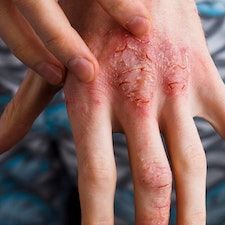Elevated IgE, Atopic Disease Shown to Help Predict Atopic-Like Dermatitis in Psoriasis Patients Using IL-17A Inhibitors
This study’s findings demonstrate the necessity of risk factor identification for atopic-like dermatitis, as well as the importance of exploring alternative treatments for severe cases.

Elevated immunoglobulin E (IgE) levels and atopic disease history may predict atopic-like dermatitis (ALD) incidence for those with psoriasis using IL-17A inhibitors, according to new findings, indicating an overall need for identification of risk.1
These findings came from a recent study which was conducted to assess the risk factors, prevalence, outcomes, and treatment of the condition known as ALD among individuals with psoriasis and given IL-17A inhibitor treatment.
Recent data points to environmental factors and immunological factors contributing to ALD development, but research on risk factors of ALD induction thanks to IL-17A inhibitors are limited.2
Given that to date, there is little information available on the management of drug-induced ALD, this study was conducted by the team and it was authored by Kun Huang, MD, PhD, from the Department of Dermatology at the First Affiliated Hospital of Chongqing Medical University in China.
“ALD can develop consequent to IL-17A inhibitor use, which can often lead to misdiagnosis and poor management,” Huang and colleagues wrote. “Thus, this study aimed to estimate the frequency of IL-17A inhibitor-induced ALD and explore its clinical correlates, risk factors, and treatments in a psoriasis cohort.”
Background and Findings
The investigators used a retrospective study design and included participants who both had psoriasis and had or did not have psoriatic arthritis. Additionally, these participants would have developed ALD at the time of their treatment with IL-17A inhibitors at the First Affiliated Hospital of Chongqing Medical University in China, specifically in the period of July of 2020 - July of 2022.
They used participants’ severity of their psoriasis at the time of onset of ALD, their body surface area (BSA), psoriasis area and severity index (PASI), and dermatology life quality index (DLQI) score, in addition to personal and family history of atopic illness.
The research team also collected data on such factors as sex, age, IL-17A inhibitor type, IL-17A inhibitor duration in weeks, body mass index (BMI), the existence of ALD for a participant, atopic dermatitis severity based upon eczema area and severity index (EASI), scoring atopic dermatitis index (SCORAD), and on the numerical rating scale (NRS).
The team also gathered such information as laboratory indices—serum IgE levels and eosinophil levels—and data on environmental effects on disease—pet ownership history, smoking habits, and history of drug allergy.
ALD lesions were characterized by the investigators as the typical manifestation, with features including lichenified and excoriated plaques, papules, erythema, and predominant occurrence in flexural regions. A consensus evaluation was made by 3 dermatologists for all participants with ALD, with dermoscopy employed by the team as needed.
The team determined that a Naranjo score of ≥4 suggested a connection between ALD and IL-17A inhibitors. Wherever possible, the scope and distribution of ALD, in addition to dermatological interventions, were assessed. ALD treatment procedures and results were documented by the team, and those not followed up over the 2-year period were omitted from their analysis.
Overall, the investigators found that among the 226 patients analyzed, 14 were shown to have experienced ALD. The team’s results suggested that a personal history of atopic disease (odds ratio [OR] 27.830, 95% confidence interval [CI] 3.801 - 203.770; P = 0.001) as well as elevated IgE levels (OR 5.867, 95% CI 1.131 - 30.434; P = 0.035) were found to be independent predictors of incident ALD.
In a single case, the investigators reported that anti-IL-17A therapy was shown to have been discontinued and then replaced with tofacitinib. Among the 13 participants who continued to use IL-17A inhibitor treatment, ALD was shown to be either somewhat or completely resolved as a result of topical therapy and/or antihistamines.
“The findings of our study suggest that a personal history of atopic disease and an elevated IgE level are risk factors for IL-17A inhibitor-induced ALD,” they wrote. “After ALD develops, it is crucial to balance the risks and benefits of continuing the original drug. Personalized strategies are recommended according to the severity of ALD and psoriasis, and a prudent evaluation of the effect of skin lesions on the quality of life is important.”
References
- Tang X, Li Q, Zhou Y, et al. Predictive factors of atopic-like dermatitis induced by IL-17A inhibitors in patients with psoriasis: A 2-year follow-up study [published online ahead of print, 2023 Aug 1]. J Eur Acad Dermatol Venereol. 2023;10.1111/jdv.19394. doi:10.1111/jdv.19394.
- Kantor R, Silverberg JI. Environmental risk factors and their role in the management of atopic dermatitis. Expert Rev Clin Immunol. 2017;13(1):15-26. 234 doi:10.1080/1744666X.2016.1212660.